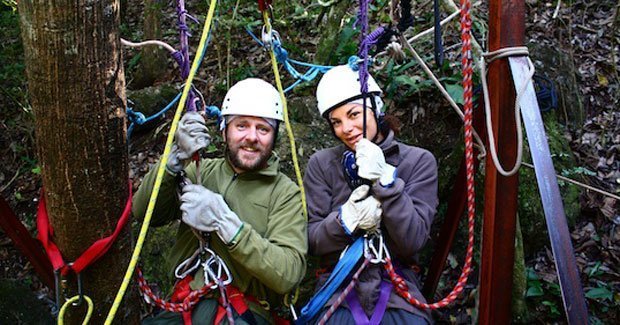Pantanal: Diving into the abyss

IT’S WHILE I’M DANGLING on a rope through a crack in the earth more than 70 m above an underground lake that I begin to seriously question my sanity – not for the first time on this journey. The lake is more than 80 m deep, but from this height, if my fastenings fail, the impact with the water will kill me instantly.
My partner Nick, who’s taking the photos, is definitely more comfortable with our slow slide down to oblivion, but because we’ve been ‘safety-tied’ together, I make him wait for me while I nervously release the rope brake. We had rappelling lessons last night on a gym wall, but that was easy peasy – a short few metres in a nicely lit hall before we nonchalantly signed our lives away.
Hanging by rope through a fissure as deep as a 25-storey building turns out to be a rather different experience. We’re halfway down when I notice a disquieting burning smell coming from the pulley I’m gripping. Nick notices it too. “Maybe it’s the friction gloves we’re wearing,” I say hopefully. “No,” Nick confirms, “it’s definitely the rope”. Yikes.
The cave we are exploring is in South America’s the Pantanal, the world’s largest tropical wetland covering more than 150,000 square km. We are near to a town called Bonito in Brazil’s southwestern province of Mato Grosso do Sul.
Entering the subterranean cave
We tour the cavern by torchlight, finding a curtain of folded limestone, chandeliers of rock that occasionally break off (we wear helmets throughout) and monoliths decorated with crystalline rosettes.
The water here is incredibly clear (to 50 m in summer sunlight) and peering down past the reflections of stalactites we see their mirror images growing from the cave floor. These are the world’s biggest cave stalagmites – the tallest is 19.5 m – and we change quickly into wetsuits, eager to see them up close.
The water is freezing cold, clear and dark. Shining our dive torches produces a bright spotlight that shrouds everything else in deeper gloom, so I keep it off and let my eyes welcome in the edges. We float 20 m down through golden cones of stalagmites, trying not to bump them and disturb their perfect preservation. An anteater skeleton lies where it died, stumbling over the hole’s edge 100 metres up.
Life in the subterranean lake
THERE ARE SMALL FISH called lambari here in this disconnected pool of water, grown from eggs dropped by birds. They eat the little algae that grows here and hungrily feast on our dead skin cells. Below 30 m, tiny shrimp inhabit the waters, swimming out of the range of the fish.
The cave was only discovered a few decades ago when firefighters putting out a bush blaze here revealed the crack. The soluble limestone makes for many caves and there are more than 20 in the 30 kilometre radius of the town of Bonito. The Anhumas cave was first explored in 1984 by geologists who were astonished at the scale of the stalagmites. Tours here began a decade later, presumably once they’d worked out how to get tourists in and out without dropping them.
We ascend the lake and then prepare for a greater ascent: out of the cave. Climbing 72 metres out of this subterranean hole isn’t easy. We do it by an exhausting method of hauling ourselves up with our arms, using the rappel grips, and then pushing down with our legs.
It’s a slow, painful process that takes the fastest experienced guide an impossible 3mins 40 secs, but takes us more than 20 minutes. Up and out, back in the warm sunlight, it feels as if we have emerged from a different world.
Gaia Vince is an Australian journalist who is travelling around the world reporting on the effects of climate change and sending regular dispatches to Australian Geographic. She writes for the BBC, New Scientist and The Guardian. Find her blog at wanderinggaia.com.
RELATED STORIES


